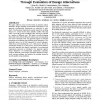PDP
2002
IEEE
14 years 5 months ago
2002
IEEE
Existing distributed middleware technologies and Enterprise Application frameworks lack in support to service flexibility from both the developer’s and user’s point of view. ...
ICSM
2002
IEEE
14 years 5 months ago
2002
IEEE
In re-engineering object-oriented legacy code, it is frequently useful to introduce a design pattern in order to improve specific non-functional requirements (e.g., maintainabili...
STEP
2003
IEEE
14 years 5 months ago
2003
IEEE
The reengineering of legacy software systems to modern Object Oriented platforms has received significant attention over the past few years. However, most often the reengineering ...
RE
2004
Springer
14 years 5 months ago
2004
Springer
One of the most important principles in Software Engineering is the separation of concerns. When this principle is correctly applied, it helps to promote comprehensibility, mainta...
RE
2004
Springer
14 years 5 months ago
2004
Springer
We present a method to identify stakeholders and their preferences about non-functional requirements (NFR) by using use case diagrams of existing systems. We focus on the changes ...
RE
2004
Springer
14 years 5 months ago
2004
Springer
In this work, we propose a framework for quantifying non-functional requirements (NFRs). This framework uses quality characteristics of the execution domain, application domain an...
CD
2004
Springer
14 years 5 months ago
2004
Springer
This paper presents an approach to describe, deploy and manage component-based applications having dynamic functional and non-functional requirements. The approach is centered on a...
CAISE
2005
Springer
14 years 6 months ago
2005
Springer
Traditional requirements engineering approaches suffer from the tyranny of the dominant decomposition, with functional requirements serving as the base decomposition and non-functi...
ISSTA
2006
ACM
14 years 6 months ago
2006
ACM
This paper addresses issues involved when an architect explore alternative designs including non-functional requirements; in our approach, non-functional requirements are expresse...
WER
2007
Springer
14 years 6 months ago
2007
Springer
Business stakeholders need to have clear and realistic goals if they want to meet commitments in application development. As a consequence, at early stages they prioritize require...






